Research on the Measurement of Particulate Matter Concentration in Diesel Vehicle Exhaust Using the Light Scattering Method
Abstract
1. Introduction
2. Principles and Design of Light Scattering Particle Matter Sensor
2.1. Principles of Measurement and Theoretical Fundamentals
2.2. The Relationship Between Scattering Angle and Scattered Light Intensity
3. Design of the Experiment
3.1. Measurement System Design
3.2. Scattering Signal Analysis
3.3. Anti-Pollution Design
4. Sensor Calibration and Testing
4.1. Calibration Experiment
4.2. Calibration Testing
5. Conclusions
Author Contributions
Funding
Data Availability Statement
Conflicts of Interest
Correction Statement
References
- Yang, X.; Guo, X.; Wang, Y. Characteristics of Carbon Emission Transfer under Carbon Neutrality and Carbon Peaking Background and the Impact of Environmental Policies and Regulations on It. Sustainability 2023, 15, 7528. [Google Scholar] [CrossRef]
- Li, P.; Lü, L. Research on a China 6b heavy-duty diesel vehicle real-world engine out NOx emission deterioration and ambient correction using big data approach. Environ. Sci. Pollut. Res. 2022, 29, 6949–6976. [Google Scholar] [CrossRef] [PubMed]
- Cai, Z.; Yan, F.; Shao, Y.; Liao, J.; Wu, Y.; Zheng, S.; Li, Y.x.; Hu, J.; Wang, Z.; Li, Z. Lumped model for evaluating dynamic filtration and pressure drop behaviour in diesel particulate filters. Fuel 2024, 365, 131311. [Google Scholar] [CrossRef]
- Ochs, T.; Schittenhelm, H.; Genssle, A.; Kamp, B. Particulate Matter Sensor for On Board Diagnostics (OBD) of Diesel Particulate Filters (DPF). SAE Int. J. Fuels Lubr. 2010, 3, 61–69. [Google Scholar] [CrossRef]
- Grondin, D.; Westermann, A.; Breuil, P.; Viricelle, J.-P.; Vernoux, P. Influence of Key Parameters on The response of A Resistive Soot Sensor. Sens. Actuators B Chem. 2016, 236, 1036–1043. [Google Scholar] [CrossRef]
- Brunel, O.; Duault, F.; Youssef, B.; Lavy, J.; Creff, Y. Smart Soot Sensor for Particulate Filter OBD. SAE Int. J. Passeng. Cars Electron. Electr. Syst. 2013, 6, 307–327. [Google Scholar] [CrossRef]
- Hagen, G.; Feulner, M.; Werner, R.; Schubert, M.; Müller, A.; Riess, G.; Brüggemann, D.; Moos, R. Capacitive Soot Sensor for Diesel Exhausts. Sens. Actuators B-Chem. 2016, 236, 1020–1027. [Google Scholar] [CrossRef]
- Zhao, H.; Wang, X.; Wang, R.; Hua, D.; Li, K.; Ji, F. Optimal static light scattering detection angle for particulate matter size and concentration measurement. Meas. Sci. Technol. 2023, 34, 125802. [Google Scholar] [CrossRef]
- Wang, X.; Chancellor, G.; Evenstad, J.; Farnsworth, J.E.; Hase, A.; Olson, G.M.; Sreenath, A.; Agarwal, J.K. A novel optical instrument for estimating size segregated aerosol mass concentration in real time. Aerosol Sci. Technol. 2009, 43, 939–950. [Google Scholar] [CrossRef]
- Renard, J.B.; Thaury, C.; Mineau, J.L.; Gaubicher, B. Small-angle light scattering byairborne particulates: Environnement S.A. continuous particulate monitor. Meas. Sci. Technol. 2010, 21, 085901. [Google Scholar] [CrossRef]
- Jourdainne, L.; Matadi Boumbimba, R.; Triki, B.; Bouquey, M.; Muller, R.; Hébraud, P.; Pfeiffer, P. Compact and flexible optical sensor designed for on-line monitoring. Int. J. Mater. Form. 2012, 5, 1–9. [Google Scholar] [CrossRef]
- Gao, R.S.; Telg, H.; McLaughlin, R.J.; Ciciora, S.J.; Watts, L.A.; Richardson, M.S.; Schwarz, J.P.; Perring, A.E.; Thornberry, T.D.; Rollins, A.W.; et al. Alight-weight high-sensitivity particle spectrometer for PM2.5 aerosol measurements. Aerosol Sci. Technol. 2016, 50, 88–99. [Google Scholar] [CrossRef]
- Wang, X.; Hoekman, S.; Han, Y.; Chow, J.C.; Watson, J.G.; Wu, X.; Wu, Y.; Schuetzle, D.; Schuetzle, R. Potential emission reductions by converting agricultural residue biomass to synthetic fuels for vehicles and domestic cooking in China. Particuology 2020, 49, 40–47. [Google Scholar] [CrossRef]
- Han, J.; Liu, X.; Jiang, M.; Wang, Z.; Xu, M. An improved on-line measurement method of particulate matter concentration using tri-wavelength laser light scattering. Fuel 2021, 302, 121197. [Google Scholar] [CrossRef]
- Shao, W.; Zhang, H.; Zhou, H. Fine Particle Sensor Based on Multi-Angle Light Scattering and Data Fusion. Sensors 2017, 17, 1033. [Google Scholar] [CrossRef] [PubMed]
- Venkatraman Jagatha, J.; Klausnitzer, A.; Chacón-Mateos, M.; Laquai, B.; Nieuwkoop, E.; van der Mark, P.; Vogt, U.; Schneider, C. Calibration Method for Particulate Matter Low-Cost Sensors Used in Ambient Air Quality Monitoring and Research. Sensors 2021, 21, 3960. [Google Scholar] [CrossRef]
- Liu, Y.; Daum, P.H. The Effect of Refractive Index on Size Distributions and Light Scattering Coefficients Derived From Optical Particle Counters. J. Aerosol Sci. 2000, 31, 945–957. [Google Scholar] [CrossRef]
- Bain, A.; Rafferty, A.; Preston, T.C. Determining the size and refractive index of single aerosol particles using angular light scattering and Mie resonances. J. Quant. Spectrosc. Radiat. Transf. 2018, 221, 61–70. [Google Scholar] [CrossRef]
- Li, X.; Shen, J.; Wang, M.; Mu, T.; Liu, W.; Wang, Y.; Younas, T.; Gao, M.; Wang, Q. On-line measurement for velocity and particle size distribution of flowing aerosol by dynamic light scattering. Opt. Lasers Eng. 2023, 160, 107271. [Google Scholar] [CrossRef]
- Vazquez-Pufleau, M.; Winkler, P.M. Development of an ultraviolet constant angle Mie scattering detector toward the determination of aerosol growth kinetics in the transition and free molecular regime. Aerosol Sci. Technol. 2020, 54, 917–928. [Google Scholar] [CrossRef]
- Han, Y.; Ding, L.; Wang, Y.; Zheng, H.; Fang, L. Shape Discrimination of Individual Aerosol Particles Using Light Scattering. Sensors 2023, 23, 5464. [Google Scholar] [CrossRef] [PubMed]
- Chen, D.; Liu, X.; Han, J.; Jiang, M.; Xu, Y.; Xu, M. Measurements of particulate matter concentration by the light scattering method: Optimization of the detection angle. Fuel Process. Technol. 2018, 179, 124–134. [Google Scholar] [CrossRef]
- Dunkhorst, W.; Lipowicz, P.; Li, W.; Hux, C.; Wang, Q.; Koch, W. In-situ characterization of e-cigarette aerosols by 90°-light scattering of polarized light. Aerosol Sci. Technol. 2018, 52, 717–724. [Google Scholar] [CrossRef]
- Zhang, J.; Zhang, Z.; Hou, L.; Zhou, W. A Novel Optical Instrument for Measuring Mass Concentration and Particle Size in Real Time. Sensors 2023, 23, 3616. [Google Scholar] [CrossRef]
- Zhang, Y.; Shen, Z.; Zhang, B.; Sun, J.; Zhang, T.; Wang, X.; Wang, T.; Xu, H.; Liu, P.; Wang, T. Carbonaceous aerosols emission reduction by using red mud additive in coal briquette. Fuel Process. Technol. 2020, 199, 106290. [Google Scholar] [CrossRef]

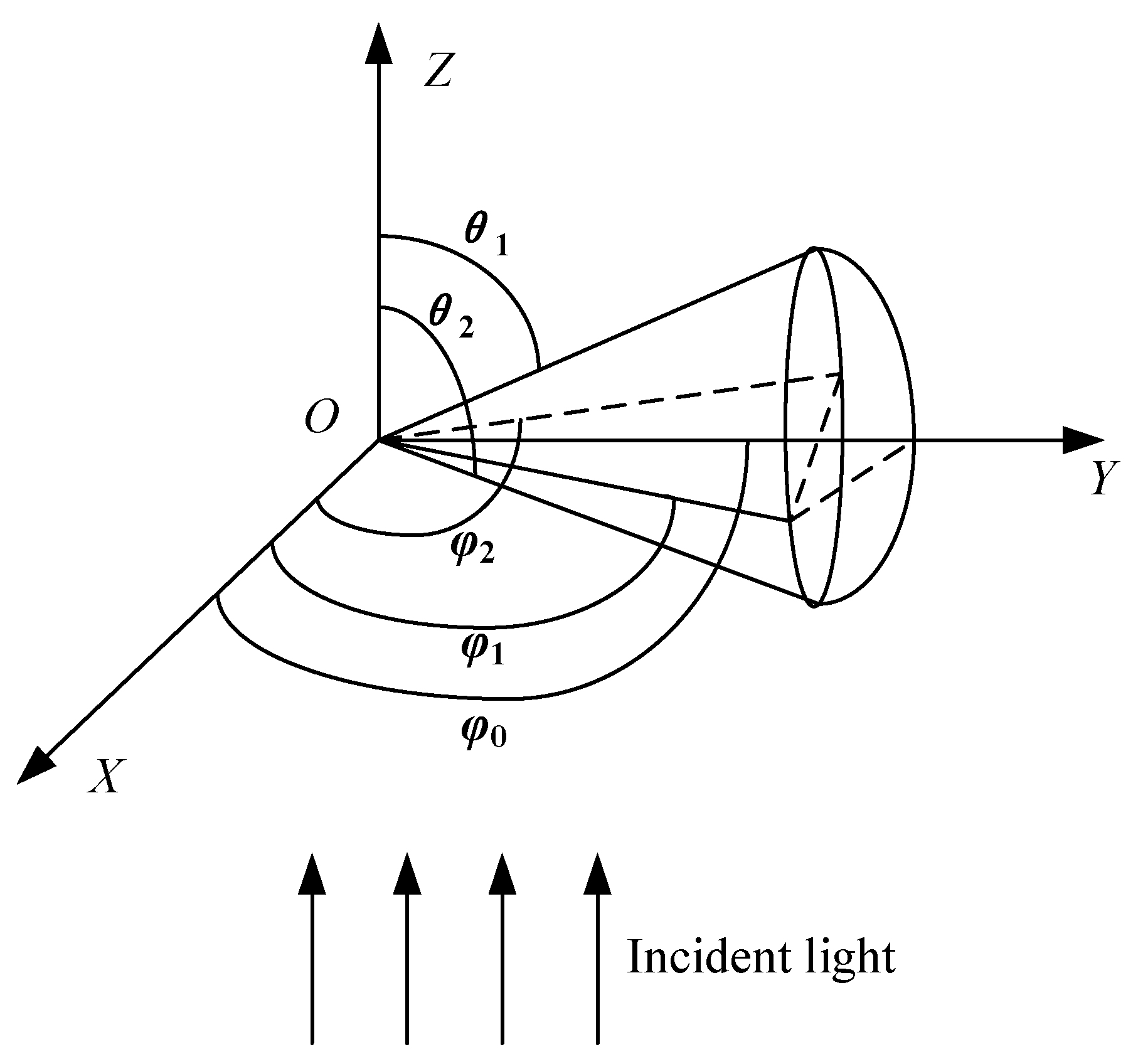
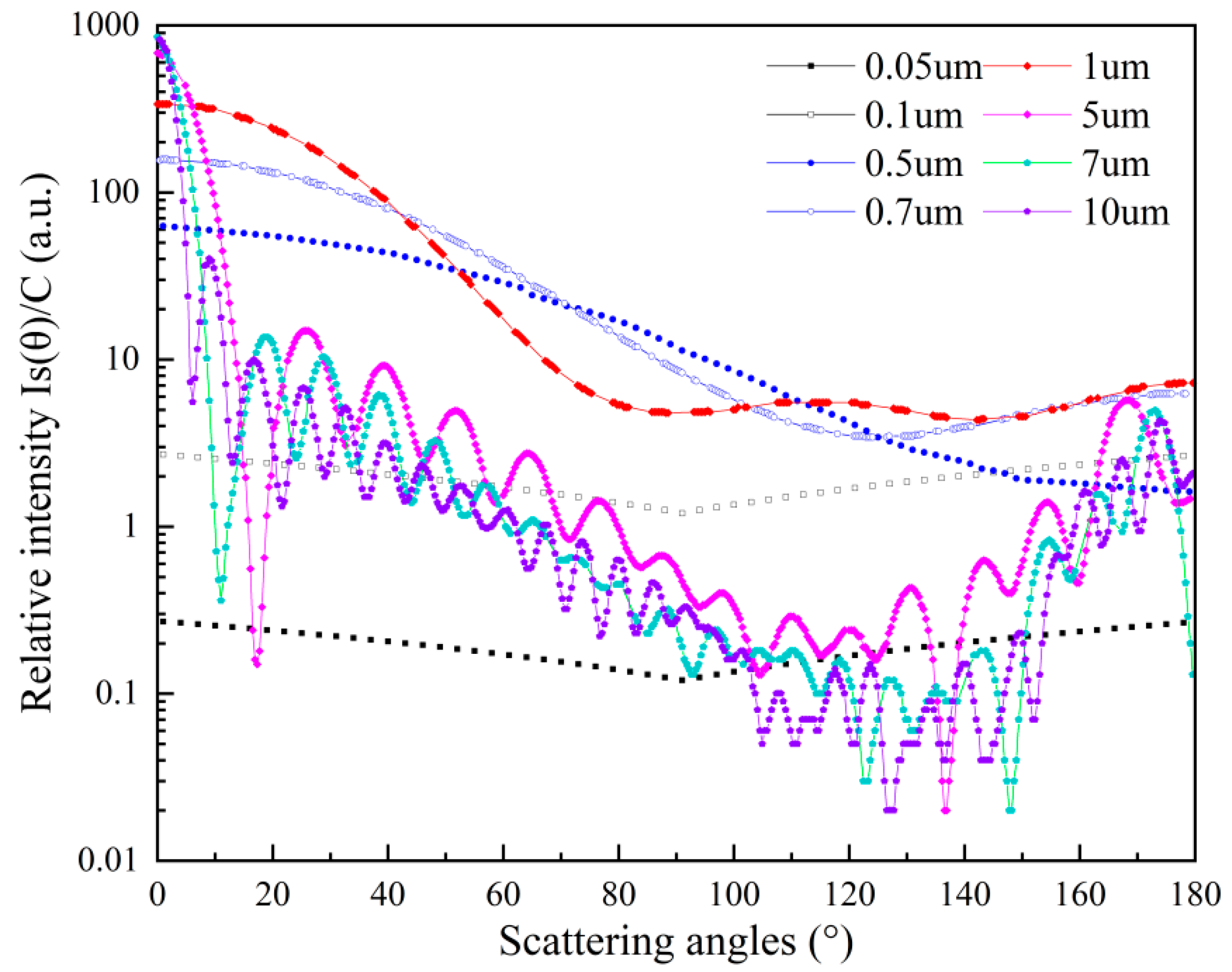
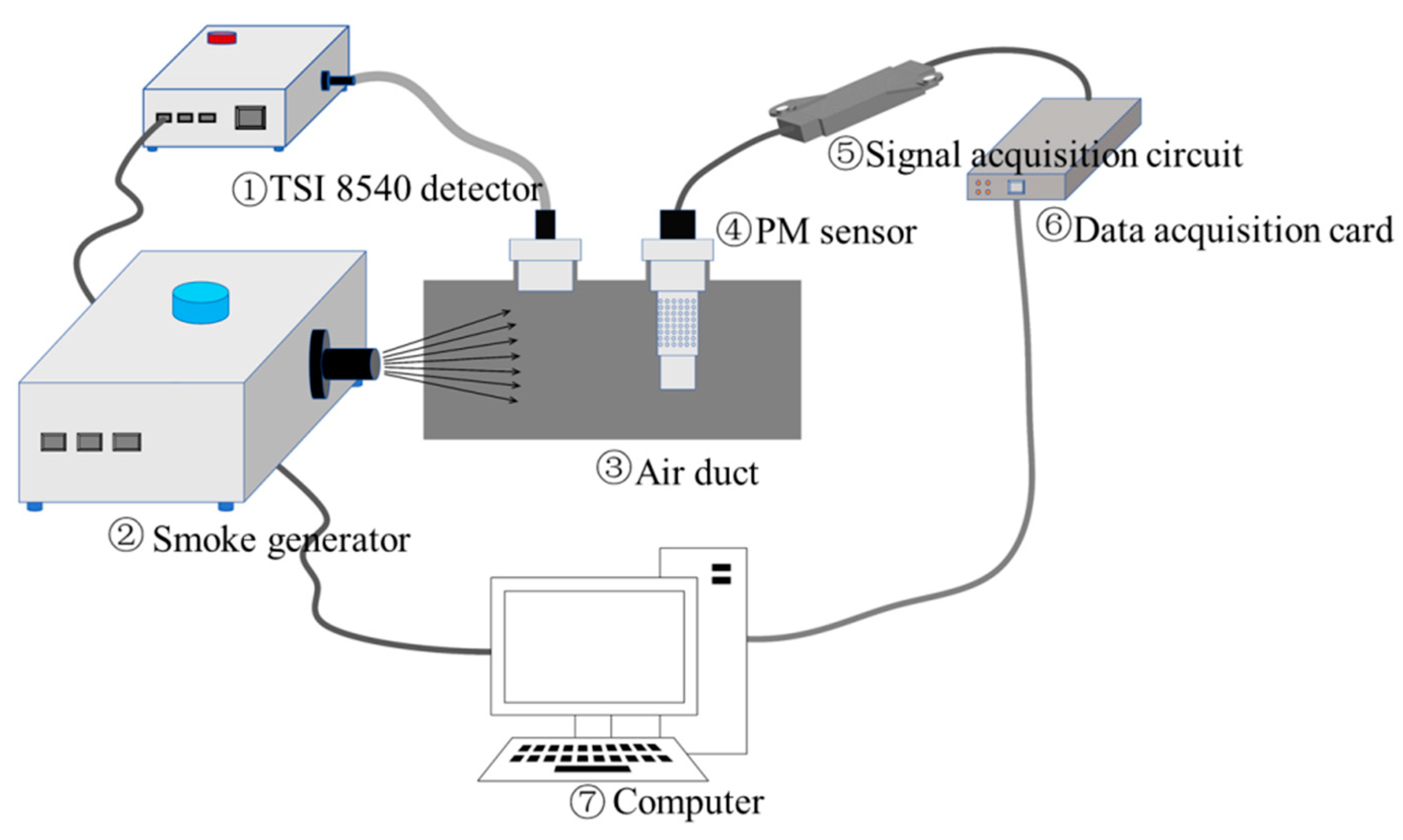

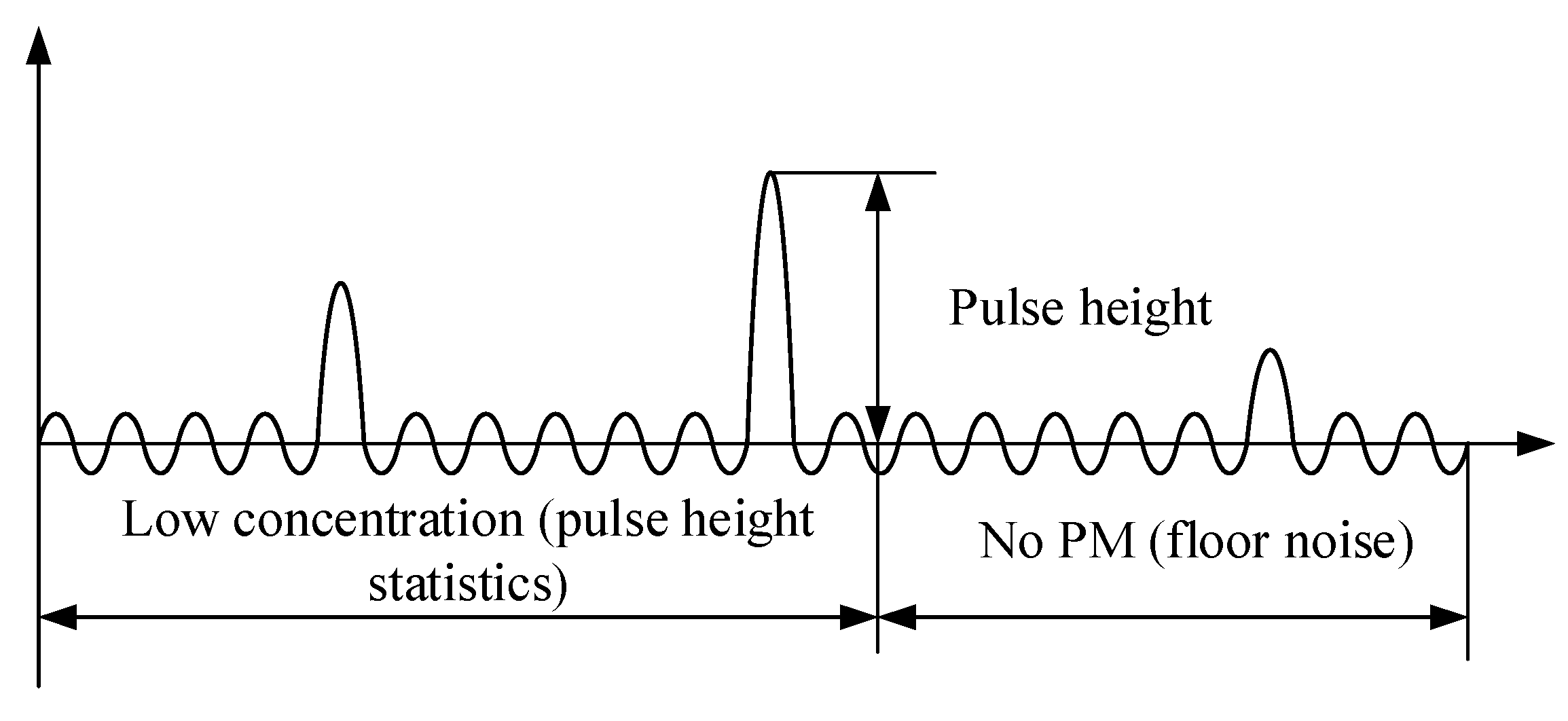





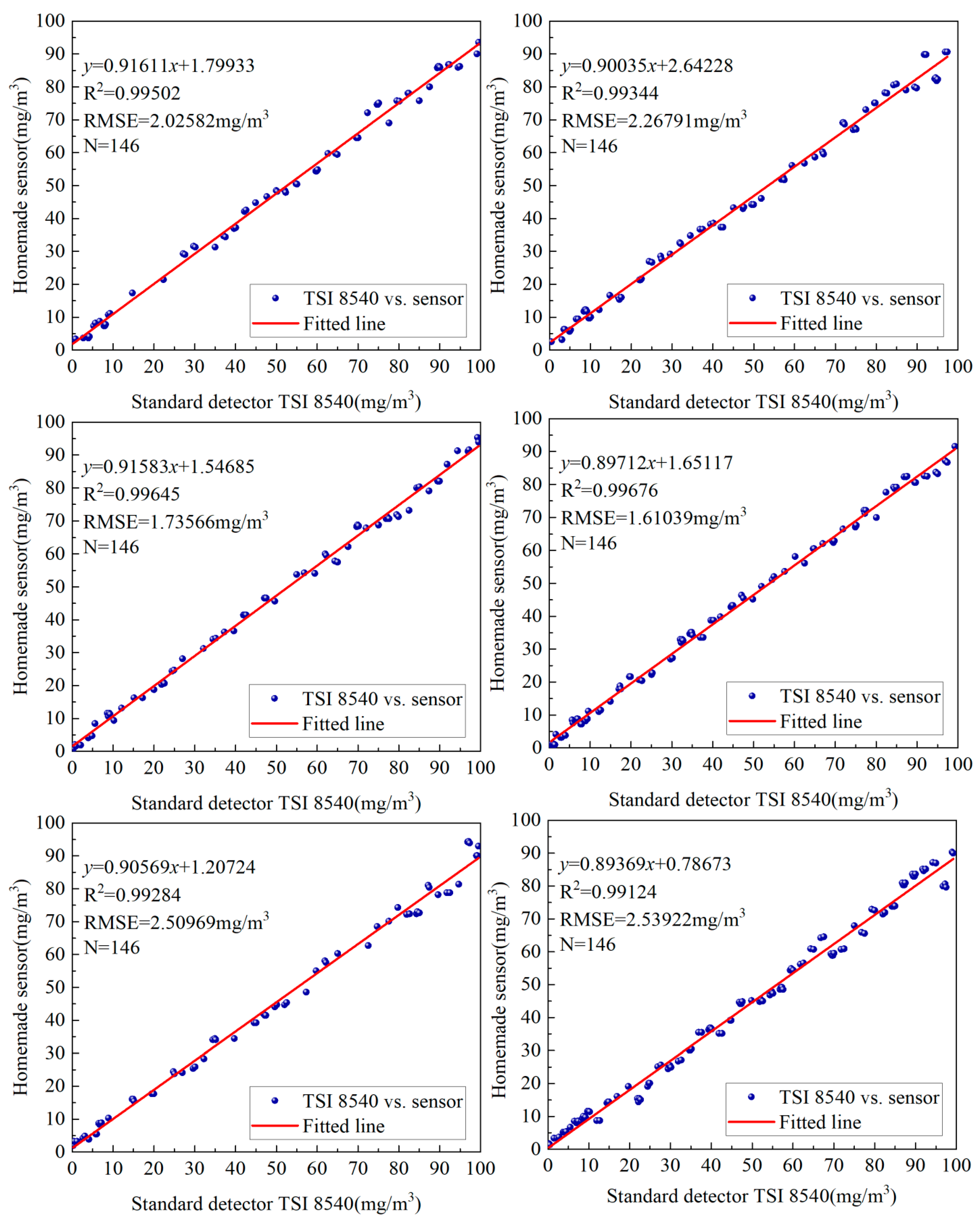
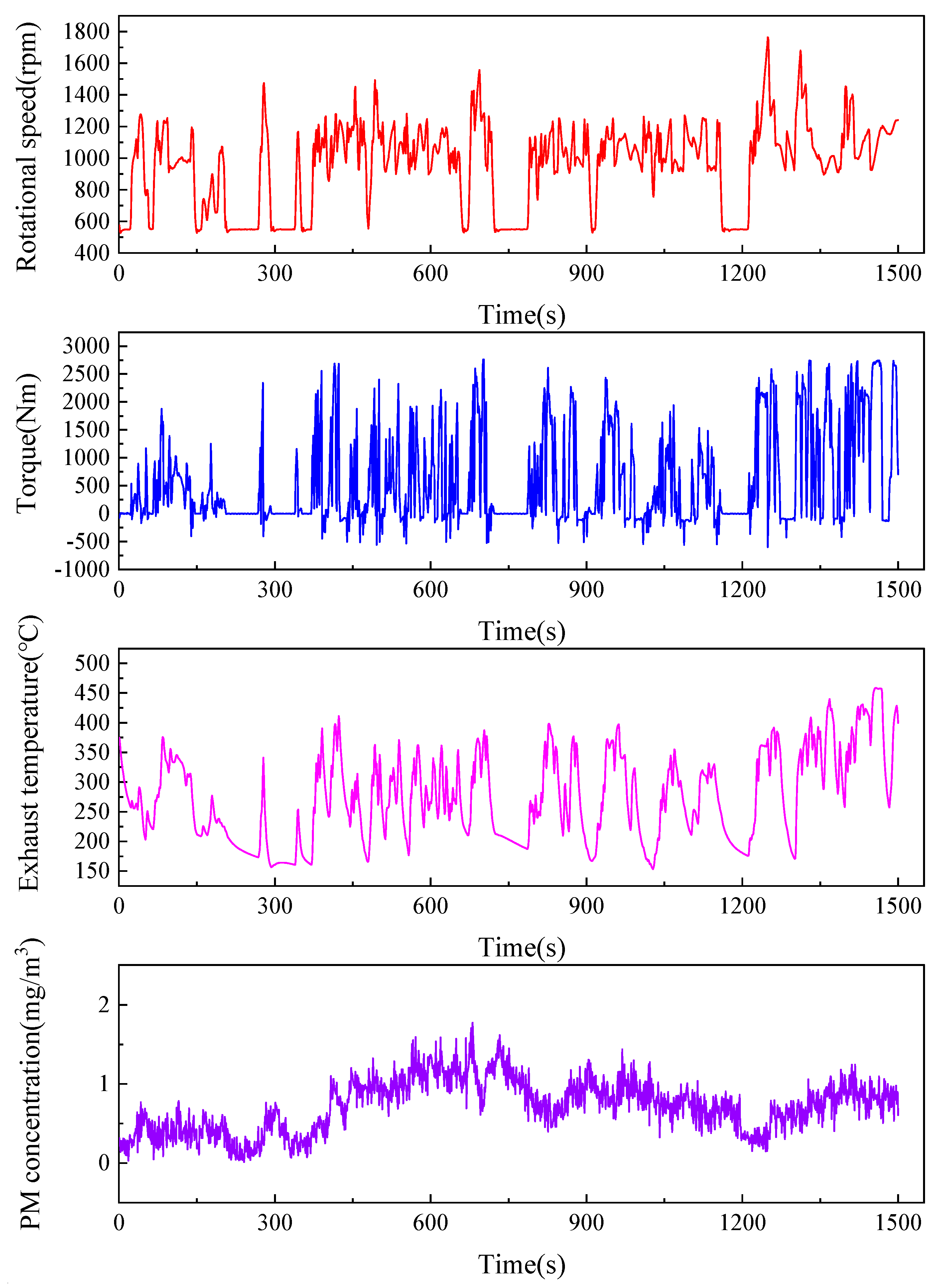
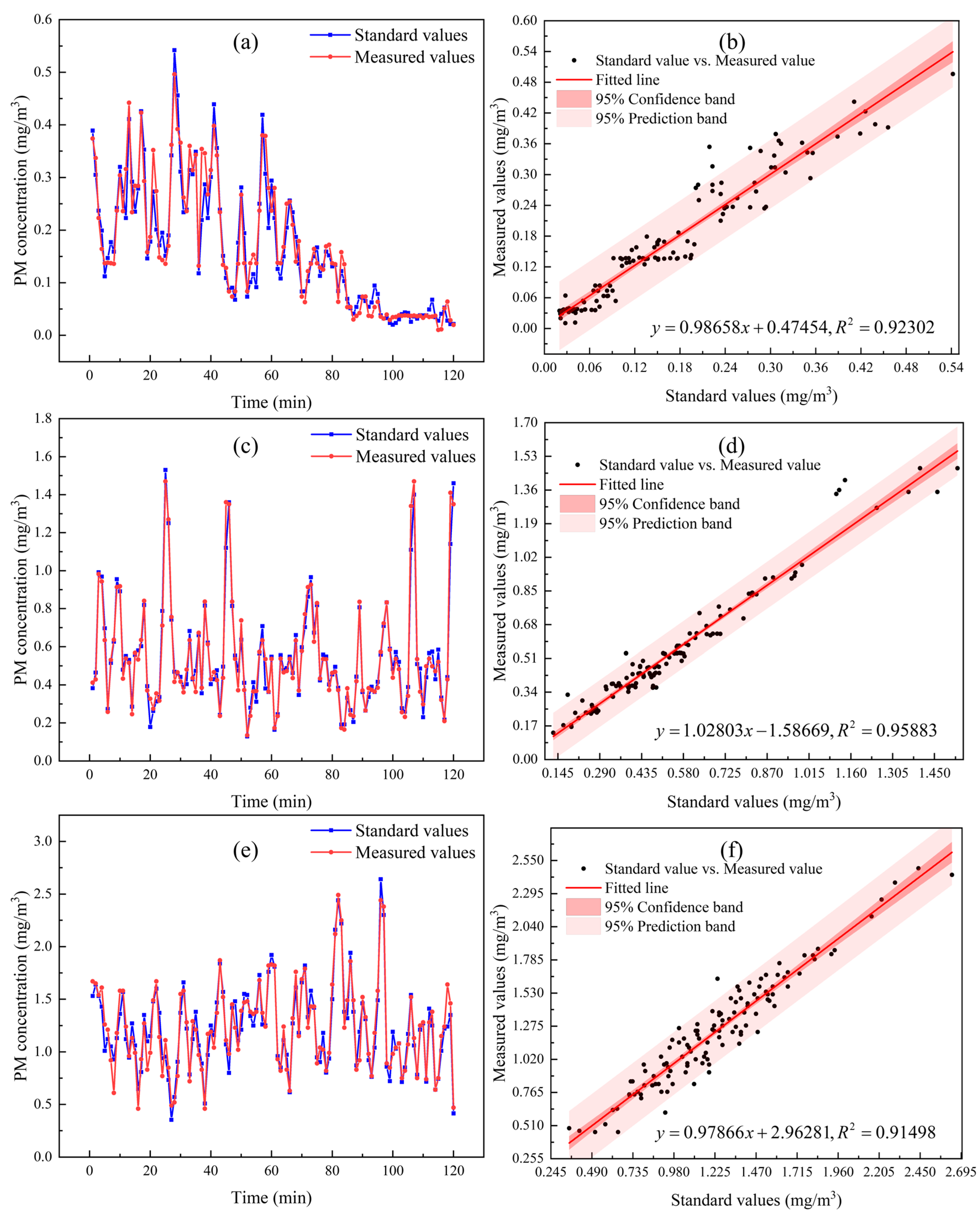
| Group | Coefficient of Determination (R2) | Root Mean Square Error RMSE (mg/m3) | Number of Particles |
|---|---|---|---|
| 1 | 0.99502 | 2.02582 | 146 |
| 2 | 0.99344 | 2.26791 | 146 |
| 3 | 0.99645 | 1.73566 | 146 |
| 4 | 0.99676 | 1.61039 | 146 |
| 5 | 0.99284 | 2.50969 | 146 |
| 6 | 0.99124 | 2.53922 | 146 |
Disclaimer/Publisher’s Note: The statements, opinions and data contained in all publications are solely those of the individual author(s) and contributor(s) and not of MDPI and/or the editor(s). MDPI and/or the editor(s) disclaim responsibility for any injury to people or property resulting from any ideas, methods, instructions or products referred to in the content. |
© 2025 by the authors. Licensee MDPI, Basel, Switzerland. This article is an open access article distributed under the terms and conditions of the Creative Commons Attribution (CC BY) license (https://creativecommons.org/licenses/by/4.0/).
Share and Cite
Wang, J.; Liu, X.; Wang, C.; Qiu, Y.; Zhou, J.; Dang, Q. Research on the Measurement of Particulate Matter Concentration in Diesel Vehicle Exhaust Using the Light Scattering Method. Sensors 2025, 25, 1898. https://doi.org/10.3390/s25061898
Wang J, Liu X, Wang C, Qiu Y, Zhou J, Dang Q. Research on the Measurement of Particulate Matter Concentration in Diesel Vehicle Exhaust Using the Light Scattering Method. Sensors. 2025; 25(6):1898. https://doi.org/10.3390/s25061898
Chicago/Turabian StyleWang, Jie, Xinjian Liu, Chao Wang, Yiyang Qiu, Jie Zhou, and Qi Dang. 2025. "Research on the Measurement of Particulate Matter Concentration in Diesel Vehicle Exhaust Using the Light Scattering Method" Sensors 25, no. 6: 1898. https://doi.org/10.3390/s25061898
APA StyleWang, J., Liu, X., Wang, C., Qiu, Y., Zhou, J., & Dang, Q. (2025). Research on the Measurement of Particulate Matter Concentration in Diesel Vehicle Exhaust Using the Light Scattering Method. Sensors, 25(6), 1898. https://doi.org/10.3390/s25061898






